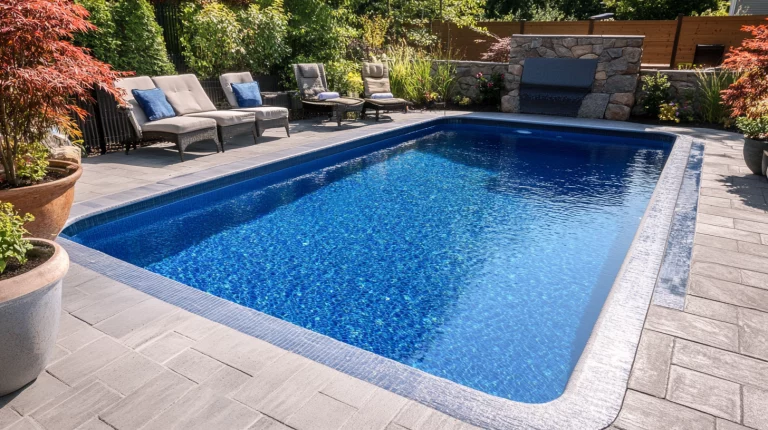Fibreglass pools are renowned for their durability, low maintenance, and smooth surface. They offer a stylish and functional addition to your backyard, providing countless hours of relaxation and enjoyment. However, like any significant investment, taking proper care of your fibreglass pool is essential for maintaining its beauty and functionality over the years.
With the right care and attention, you can significantly extend the lifespan of your fibreglass pool, ensuring it serves you well for decades to come.
In this article, we’ll cover a variety of essential maintenance practices and tips on how to extend the life of your fibreglass pool, from regular cleaning to proper chemical balance and repairs. Let’s dive in! Or discover a pool installer in perth.
1. Regular Cleaning and Maintenance
Routine cleaning is crucial to ensuring your fibreglass pool remains in excellent condition. Regular maintenance not only enhances the appearance of the pool but also prevents the build-up of debris and contaminants that could lead to damage.
Skim the Pool Daily
One of the simplest yet most effective ways to keep your fibreglass pool in top shape is by skimming it daily. Leaves, twigs, and insects can accumulate on the surface of the water and, if left unattended, may lead to stains or clogging in the filtration system. Use a fine mesh skimmer net to remove debris from the pool daily. This prevents it from sinking to the bottom, where it can be more difficult to remove.
Clean the Pool Floor and Walls Weekly
The floor and walls of your fibreglass pool need attention as well. A robotic pool cleaner or a manual vacuum can help remove dirt, debris, and algae from the pool’s surface. Ensure you clean the pool floor and walls at least once a week, especially in high-use seasons. Pay special attention to areas around steps, corners, and ledges where dirt can accumulate more easily.
Clean the Pool Filter Regularly
A clean pool filter is essential for maintaining proper water circulation and preventing debris from circulating throughout the pool. Depending on the type of filter (sand, cartridge, or diatomaceous earth), cleaning schedules will vary. Regularly backwash or clean your filter to ensure it continues to operate efficiently. A clogged filter can reduce water flow and strain the pool’s pump, potentially shortening its lifespan.
2. Maintain Proper Chemical Balance
One of the most important aspects of pool care is ensuring the water chemistry is balanced. The right balance of chemicals can protect your fibreglass pool from corrosive elements and harmful growths like algae.
Test Water Chemistry Regularly
Make it a habit to test your pool water regularly, at least once a week, and adjust the levels as needed. The primary factors to monitor are:
- pH levels: Maintain a pH level between 7.4 and 7.6 to ensure water is neither too acidic nor too alkaline.
- Chlorine levels: Chlorine should be kept between 1 and 3 parts per million (ppm) to sanitise the pool and prevent algae growth.
- Total Alkalinity: Ideal levels of total alkalinity are between 80 and 120 ppm to help buffer the pH level.
- Calcium Hardness: Ensure calcium hardness is between 200 and 400 ppm to prevent the water from becoming too soft, which can damage the pool’s surface.
Use Stabilised Chlorine
To help prolong the life of your fibreglass pool, use stabilised chlorine, as it helps to protect the pool’s surface from the damaging effects of UV rays. This chemical also keeps your pool cleaner for a longer period, reducing the need for additional chlorine treatments.
Regularly Shock the Pool
Pool shock is a powerful dose of chlorine or other sanitising chemicals that helps to kill any bacteria or algae that may be present in the water. Shocking your pool every 1-2 weeks or after heavy rainfall can help keep the water clean and free of contaminants. It is also beneficial after hosting pool parties or other events where the pool experiences heavy usage.
3. Proper Water Circulation
Good water circulation is essential to ensuring the even distribution of chemicals, maintaining clear water, and reducing the risk of algae build-up. A properly functioning circulation system reduces strain on the filtration system and helps maintain the pool’s overall health.
Run the Pump for the Recommended Time
The pool pump is responsible for circulating water through the filtration system. To ensure effective filtration and water movement, it’s crucial to run the pump for the recommended amount of time. Typically, you should run the pump for 8-12 hours per day, depending on the size of your pool, the water temperature, and the number of swimmers.
If you have a variable-speed pump, you can adjust the run time and speed to improve energy efficiency, which will not only save on electricity but also extend the lifespan of your pool equipment.
Avoid Overworking the Pump and Filter
While regular pump operation is essential, you should avoid running the pump for too long or at a higher speed than necessary. Overworking the pump and filter system can cause wear and tear over time. Stick to the recommended run time, and only increase the speed when necessary.
4. Prevent Damage to the Pool Surface
Fibreglass is durable, but it’s not invincible. The pool surface can be damaged by harsh chemicals, abrasive materials, or physical impacts. To protect your fibreglass pool, it’s important to take steps to prevent damage.
Be Cautious with Pool Toys and Equipment
Sharp or abrasive pool toys and equipment can scratch or damage the smooth surface of a fibreglass pool. Avoid dragging heavy items like pool ladders or cleaning equipment across the pool’s surface, as this can cause surface wear.
Use Pool Covers
A pool cover is an excellent investment for protecting your fibreglass pool from debris, dirt, and direct sunlight when not in use. A cover helps reduce the need for constant cleaning and minimises the risk of damage from external factors. It also helps maintain consistent water temperature and reduces chemical consumption.
Repair Surface Damage Immediately
If you notice any cracks, chips, or damage to the pool’s surface, it’s important to address it immediately. While fibreglass pools are resistant to many types of damage, they are still susceptible to physical impacts. Small cracks can be repaired relatively easily with pool-safe epoxy resin.
Conclusion
By implementing a comprehensive maintenance routine, paying attention to water chemistry, and taking steps to prevent damage, you can significantly extend the lifespan of your fibreglass pool.
Regular cleaning, proper chemical balance, and proactive care are essential to ensuring your pool continues to provide enjoyment for many years to come.

